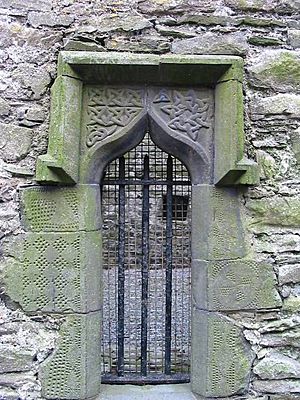The Mint (Carlingford) facts for kids
Quick facts for kids The Mint |
|
|---|---|
| Native name Irish: An Mionta |
|
 |
|
| Type | Fortified house |
| Location | Tholsel Street, Carlingford, County Louth, Ireland |
| Area | Cooley Peninsula |
| Built | 15th/16th century |
| Owner | State |
| Official name: The Mint | |
| Reference no. | 242 |
| Lua error in Module:Location_map at line 420: attempt to index field 'wikibase' (a nil value). | |
The Mint is an old, strong house in Carlingford, Ireland. It's known as a 'fortified house' because it was built to be safe and protected. It's also a special National Monument, which means it's an important historical site in Ireland. You can find The Mint in the southern part of Carlingford, about 120 meters southwest of Carlingford Lough.
The Mint's Story
This old building is sometimes called a fortified house or a tower house. It got its name, "The Mint," because the town of Carlingford was given permission to make coins there in 1467 by King Edward IV.
However, the building we see today was built later, either in the 1400s or 1500s. People think it might have been the home of a rich merchant family from Carlingford. But, it doesn't have a fireplace, and its defenses are very strong. This makes some people wonder if it really was used as a place to make coins. The interesting thing is that no coins made in Carlingford have ever been found!
What the Building Looks Like
The Mint has three floors and is mostly made of limestone. On the roof, there's a special walkway called a chemin de ronde with battlements. These battlements have small openings called loopholes that were used for muskets (old guns). The main door is protected by a machicolation, which is a floor opening that allowed defenders to drop things on attackers below.
The windows on the ground and first floors face the street. There are five of these windows, and they have a special curved shape called an Ogee arch. You can see cool carvings around them, like a horse, a person's head, a bird, a snake, and Celtic interlace designs. These designs show that people in the 1400s and 1500s were very interested in Celtic art again. The windows also have hood mouldings (decorative frames above them) and mullions (vertical bars that divide the window).


